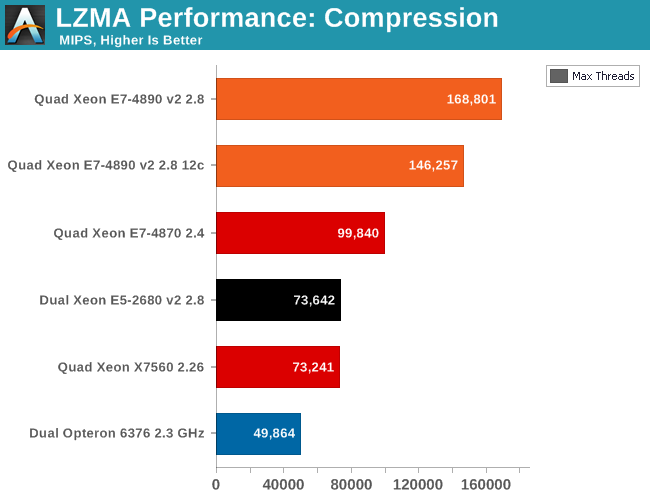The Intel Xeon E7 v2 Review: Quad Socket, Up to 60 Cores/120 Threads
by Johan De Gelas on February 21, 2014 6:00 AM EST- Posted in
- IT Computing
- Intel
- Xeon
- Ivy Bridge EX
- server
- Brickland
Multi-Threaded Integer Performance
How do the new Xeon E7 v2 chips compare to the existing Xeon servers when it comes to some multi-threaded workloads?

When it comes to raw integer processing, the new Xeon delivers up 70% better performance than the previous generation and up to 2.3x better performance than the Xeon X7560. With only 12 cores active to simulate performance of the 12-core models, e.g. E7-8857 v2 and E7-4860 v2, we can get a rough idea how the interesting 3GHz 12-core E7-8857 v2 performs, which has the same TDP (130W) as the previous generation. In those circumstances the new Xeon E7 v2 is 50% faster than the previous generation and twice as fast as the Xeon 7560 (and the actual E7-8857 v2 will be clocked slightly higher).

Decompression gives a similar performance landscape, though the E5-2680 now drops below the X7560.










125 Comments
View All Comments
JohanAnandtech - Saturday, February 22, 2014 - link
I meant, I have never seen an independent review of high-end IBM or SUN systems. We did one back in the T1 days, but the product performed only well in a very small niche.Phil_Oracle - Monday, February 24, 2014 - link
Contact your Oracle rep and I am sure we'd be glad to loan you a SPARC T5 server, which we have in our loaner pool for analysts and press. Would be nice if you had a more objective view on comparisons.Phil_Oracle - Monday, February 24, 2014 - link
If you look at Oracles Performance/Benchmark blog, we have comparisons between Xeon, Power and SPARC based on all publicly available benchmarks. As Oracle sells both x86 as well as SPARC, we sometimes have benchmarks available on both platforms to compare.https://blogs.oracle.com/BestPerf/
Will Robinson - Saturday, February 22, 2014 - link
Intel and their CPU technology continues to impress.Those kind of performance increase numbers must leave their competitors gasping on the mat.
Props for the smart new chip. +1
Nogoodnms - Saturday, February 22, 2014 - link
But can it run Crysis?errorr - Saturday, February 22, 2014 - link
My wife would now the answer to this considering she works for ibm but considering software costs far exceed hardware costs on a life cycle basis does anyone know what the licensing costs are between the different platforms.She once had me sit down to explain to her how CPU upgrades would effect db2 licenses. The system is more arcane and I'm not sure what the cost of each core is.
For an ERP each chip type has a rated pvu metric from IBM which determines the cost of the license. Are RISC cores priced differently than x86 cores enough to partially make up the hardware costs?
JohanAnandtech - Sunday, February 23, 2014 - link
I know Oracle does that (risc core <> x86 core when it comes to licensing), but I must admit, Licensing is extremely boring for a technical motivated person :-).Phil_Oracle - Monday, February 24, 2014 - link
In total cost of ownership calculations, where both HW and SW as well as maintenance costs are calculated, the majority of the costs (upwards of 90%) are associated with software licensing and maintenance/administration- so although HW costs matter, it’s the performance of the HW that drives the TCO. For Oracle, both Xeon and SPARC have a per core license factor of .5x, meaning 1 x license for every two cores, while Itanium and Power have a 1x multiplier, so therefore Itanium/Power must have a 2x performance/core advantage to have equivalent SW licensing costs. IBM has a PVU scale for SW licensing, which essentially is similar to Oracle but more granular in details. Microsofts latest SQL licensing follows similarly. So clearly, performance/CPU and especially per core matters in driving down licensing costs.Michael REMY - Sunday, February 23, 2014 - link
that would have be very good to test this cpu on 3D rendering benchmark.i can imagine the gain of time in a workstation...even the cost will be nearest a renderfarm...
but comparing this xeon to other one in that situation should have bring a view point.
JohanAnandtech - Sunday, February 23, 2014 - link
What rendering engine are you thinking about? Most engines scale badly beyond 16-32 threads